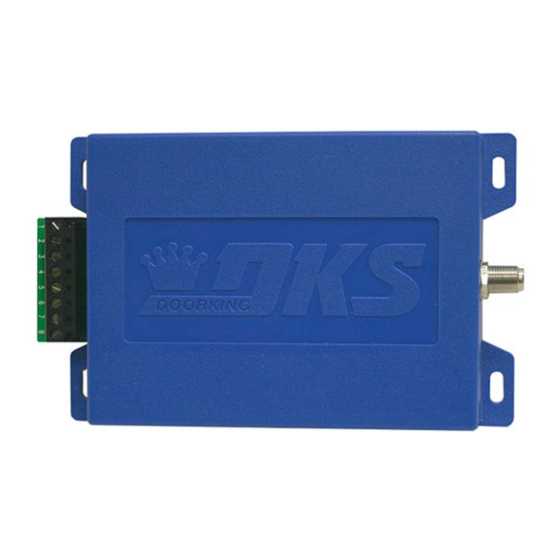
Advertisement
Quick Links
MODEL 8040 MicroPLUS
The model 8040 RF Receiver is designed for use as a Stand-Alone or Weigand applications using MicroPLUS
MicroCLIK™ transmitters. A built-in dry contact form "C" relay can directly control a gate operator if desired. A "Master"
transmitter can be setup to quickly put the RF receiver into "Learn Mode" to program in additional transmitter codes.
The RF receiver current draw may be reduced to about 1 milliampere average for solar gate operator applications.
®
MicroPLUS
Transmitter Codes
The 8040 RF receiver can handle up to 5300 MicroPLUS
®
output MicroPLUS
transmitter codes to a Weigand controller in 26, 30 or 31-bit Weigand format.
The received transmitter code MUST match the programmed
"Transmitter Code", "Facility Code" (or not match the Facility
Code if a Weigand controller is used), and "Transmitter Button
Code" before the receiver will respond.
™
MicroCLIK
Transmitter Codes
The 8040 RF receiver can handle up to 100 MicroCLIK™ transmitter codes. The RF Receiver will output MicroCLIK™ transmitter codes to a
Weigand controller in 26, 30 or 31-bit Weigand format.
The received transmitter code MUST match the programmed
"Transmitter Code", "Facility Code" (or not match the Facility
Code if a Weigand controller is used), and "Transmitter Button
Code" before the receiver will respond.
Installation
This receiver is NOT designed to be installed outdoors without
being protected from the weather. An outdoor enclosure is
available for the receiver if required, (P/N 8057-110 - Metal
Outdoor Box).
Install the 8040 receiver in a location so the antenna is NOT
surrounded by metal and is in free air as high as possible
above the ground. A longer Coax Antenna kit is available for
the receiver if required (P/N 1514-073 - Includes antenna,
mounting "L" bracket and 15 feet of coax cable). An antenna
amplifier kit (P/N 8058-080) or a Yagi directional antenna kit
(P/N 1514-072) is also available for the receiver if required.
The Program LED on the side of the case will blink as RF energy is
received. If the program LED blinks or is on continuously, this indicates
that there may be interference on the frequency (318 MHz) and short range
may be the result. If this happens, try relocating the receiver or remove the
source of interference. An antenna amplifier or a directional antenna may
be needed. Note: Loop detectors and proximity card readers can cause
receiver interference.
Receiver Terminal Wiring
12-24 Volt
Separate Power Source:
Transformer
Volt AC or DC power to terminals #1 and #2.
Use minimum 18 AWG wire to power the receiver.
• If DC power is used (Transformer): Terminal #1
is NEGATIVE and terminal #2 is POSITIVE.
• Power can be supplied to the receiver by the
Weigand controller instead of a separate
power source (See below).
DC Polarity Matters!
To Receiver Terminal #1 (Neg.)
To Receiver Terminal #2 (Pos.)
8040-065-C-10-12
®
/ MicroCLIK
®
transmitter codes. The High Security Encrypted "Rotating Code" RF Receiver will
Be sure the antenna, coax shield
and F connector are completely
isolated from the ground.
Removable
receiver
terminal for
easy wiring.
Weigand Controller Wiring:
Connect 12 - 24
Receiver terminal #2 is INPUT POWER (12-24 V).
Receiver terminal #6 is Weigand input power COMMON.
Receiver terminal #7 is Weigand DATA 0.
Receiver terminal #8 is Weigand DATA 1.
Use 22 AWG shielded wire, maximum 200 feet, for Weigand controller
wiring. Connect these terminals to the corresponding terminals on
the Weigand controller. Refer to the DoorKing Weigand controller
installation manual 1835, 1837 or 1838 for specific wiring information.
Copyright 2012 DoorKing, Inc. All rights reserved.
™
RF RECEIVER (WEIGAND)
P/N 8069-080
P/N 8070-080
®
MicroPLUS
P/N 8066-080
P/N 8067-080
MicroCLIK™ Transmitters
R e
c e i
T e r
v e r
m i
n a
l
L E
m
g r a
P r o
#1 - Input Power Common
(Negative)
#2 - Input Power
12-24 Volt AC, 12-24 Volt DC (Positive)
#3 - Relay N.O. Normally Open
#4 - Relay N.C. Normally Closed
#5 - Relay Common
#6 - Weigand Common
#7 - Weigand Data 0
#8 - Weigand Data 1
DoorKing Part Number
®
or
8040-080
5300 MicroPLUS Transmitter Codes
100 MicroCLIK Transmitter Codes
P/N 8071-080
Transmitters
P/N 8068-080
18"
t o r
n e c
Coax
o n
F C
Cable
Antenna
(Included)
D
120 Glasgow Avenue
Inglewood, California 90301
Coax
Kit
U.S.A.
Advertisement

Summary of Contents for DKS 8040 microplus
- Page 1 ® ™ MODEL 8040 MicroPLUS / MicroCLIK RF RECEIVER (WEIGAND) DoorKing Part Number ® The model 8040 RF Receiver is designed for use as a Stand-Alone or Weigand applications using MicroPLUS 8040-080 MicroCLIK™ transmitters. A built-in dry contact form “C” relay can directly control a gate operator if desired. A “Master”...
- Page 2 How Receiver Functions ® The 8040 receiver responds to the MicroPLUS or MicroCLIK™ transmitter’s “Transmitter Code” that is defined by “Transmitter Button Codes” and “Facility Codes”. For example: an 8040 receiver can be programmed to respond to only the first button on a ®...
- Page 3 1. Learn Transmitters 1. Turn the Programming Selector to Position 1. 2. Press and hold Program Button until the Program LED flashes ONCE and receiver will BEEP once. Receiver is now in “Learn Mode” and will flash and beep every second for 10 seconds. 3.
- Page 4 6. Ignore Facility Code 1. Turn the Programming Selector to Position 6. 2. Press and hold Program Button until the Program LED flashes ONCE and receiver will BEEP once. 3. Receiver LED will then give a long flash and beep. 4.



Need help?
Do you have a question about the 8040 microplus and is the answer not in the manual?
Questions and answers